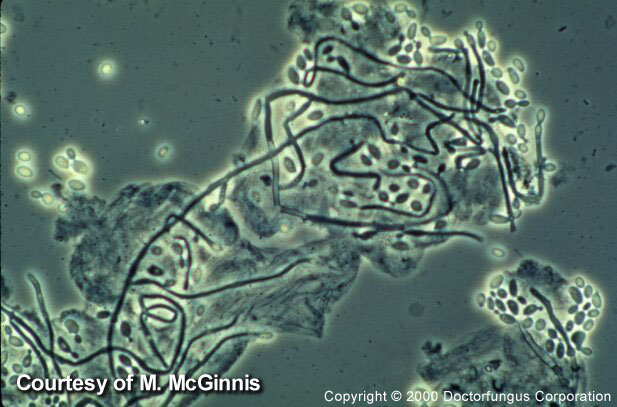Abbreviated index to disease forms that are discussed in detail
| Mucocutaneous | Invasive | Miscellaneous |
|---|---|---|
| Colonization Cutaneous Chronic Mucocutaneous Esophagitis Onychomycosis Oropharyngeal Vulvovaginitis |
Overview Bone or Joint CNS or Eye Candidemia Heart or Lung Liver, Spleen Biliary or Pancreatic Peritoneum Urinary |
Chronic Candidiasis Fever and neutropenia Fever, no neutropenia Fever in the Neonate Neonatal Candidiasis |
The Pathogen
Candida are thin-walled, small yeasts (4 to 6 microns) that reproduce by budding. Even though there are more that 150 species of Candida, no more than ten cause disease in humans with any frequency [1274]. Of these, Candida albicans causes almost 100% of cases of oropharyngeal candidiasis and at least 90% of cases of Candida vulvovaginitis. When Candida produce invasive candidiasis, the other species of Candida begin to be seen with increased frequency. For details on the mycological aspects of this fungi, see the general discussion of the N/A(L):Candida spp.
Epidemiology & Ecology
Candida spp. can be found in soil, inanimate objects, food, and hospital environments. However, it is rare for Candida spp. to produce contamination in laboratory settings.
As discussed in detail in the section on asymptomatic colonization, Candida spp. are normal commensals of man and can be recovered from many sources in normal and ill individuals. However, Candida spp. can also produce a wide variety of infections, and distinguishing between colonization and infection can sometimes be a challenge. Even though diseases related to Candida have been known for centuries, the importance of these conditions has assumed increased relevance during the last two decades.
A dramatic change in the epidemiology of infectious diseases has taken place with the advent of new chemotherapeutic agents, new immunosuppressive agents, organ transplantation, parenteral alimentation, broad-spectrum antibiotics, and advanced surgical techniques. In this new scenario, fungal infections have emerged as a critical issue in the compromised host. Among these, Candida spp. are the most common fungal pathogens [269].
Candida spp. are also competing with the bacteria as one of the leading causes of nosocomial infections [168, 646]. In addition, the ability of Candida spp. to produce oropharyngeal candidiasis in patients with HIV-AIDS has made candidiasis the leading fungal infection in this immunosuppressed population [2025].
Forms of disease
The various forms of candidiasis are the most frequent causes of fungal infection of man. Candida spp. can produce infections in both otherwise healthy individuals and in individuals with reduced immune system function.
Candidiasis of skin and mucosal surfaces
Candida spp. can both colonize (be present without causing disease) or infect any body surface. “Mucosa” refers to those body surfaces that are adapted to continuous or near-continuous exposure to moisture. Examples would be the mouth and the vagina. Cutaneous candidiasis of the neonate may remain limited to the skin or cause invasion, and we discuss this separately under neonatal candidiasis. See one of these forms of disease for more details.
Asymptomatic Colonization
Cutaneous Candidiasis
Chronic Mucocutaneous Candidiasis
Esophagitis
Onychomycosis
Oropharyngeal Candidiasis
Vulvovaginitis
Invasive candidiasis
“Invasive” implies invasion past the skin. Also called systemic candidiasis, invasive candidiasis is a complicated collection of diseases. These forms of candidiasis are only seen in individuals with reduced function of the immune system or some other type of weakening of their defenses. Almost any organ of the body may be involved. See these forms of invasive candidiasis for more details:
General Forms of Invasive Candidiasis
- The Four Overlapping Forms of Invasive Candidiasis
- Candidemia
- Intravascular Catheters and Management of Candidemia
Invasive Candidiasis of Specific Organs
Bone & Joint Candidiasis
Brain & Nerves (CNS candidiasis)
Eye (Endophthalmitis)
Gallbladder (Biliary Candidiasis)
Heart (Cardiac Candidiasis)
Lung (Candida Pneumonia)
Kidney & Bladder (Urinary Candidiasis)Liver & Spleen (Hepatosplenic Candidiasis)
Pancreas (Pancreatic Candidiasis)
Miscellaneous Syndromes
Finally, there are several forms of candidiasis or possible candidiasis that don’t fit neatly into any of the above categories. We include here our discussions of empirical therapy of fungal infections of the controversial and ill-defined group of symptoms sometimes referred to as “The Yeast Connection”.
Chronic Candidiasis (The Yeast Connection)
Empirical Therapy of Fever and Possible Fungal Infection
General Diagnostic Strategies
The diagnosis of almost any form of Candida disease requires an integration of clinical, epidemiological, and laboratory findings. Clinical manifestations for each condition are described in detail in the pages listed in the previous section.
The isolation of Candida from wounds, skin, urine, sputum, or stool specimens is not diagnostic of disease. On the other hand, growth of Candida spp. from sterile specimens (e.g., blood or CSF) is almost always diagnostic of infection. A specific diagnostic approach is discussed extensively for each condition listed above.
General Therapeutic Strategies
Special resource: You may also want to refer to the Infectious Disease Society of America-Mycoses Study Group (IDSA-MSG) Practice Guidelines for this disease. It is available at the (E):IDSA website.
A progressively larger armamentarium of N/A(L):antifungal agents began to emerge during the 1990’s. Most of these new agents have activity against Candida spp. The particular advantage of one antifungal over the other, as well as the dosage and length of therapies for each condition are discussed in detail for each of the disease forms listed above.

